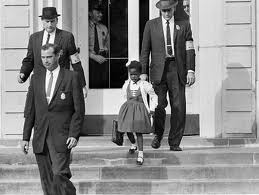Ruby`s Story |
||
Ruby Bridges was born on September 8, 1954 in Tylertown, Mississippi. At the age of four, she moved with her parents to New Orleans. When she was only six years old, her parents answered a call from the National Association for the Advancement of Colored People, volunteering Ruby as a student to participate in the integration of the public school system in New Orleans. She is the first black child to attend William Frantz Elementary School, as well as the first African American child to go to an all-white elementary school located in the South. Ruby Bridges took her entrance test in the Spring of 1960. She was one of several kindergartners to take the test. Six students were chosen, and out of the six, two of them decided not to go through with it. Three of the remaining students were assigned to attend McDonough Elementary School, but Ruby was supposed to start school at William Frantz Elementary. Her father was not an advocate of the decision. He felt that the backlash would lead to problems for Ruby as well as problems for the family. Her mother felt very strongly that Ruby should be involved in this event, and she won the argument in the end. Ruby's mom understood the impact Ruby's involvement would have on African Americans in the future. The day that she was supposed to integrate into William Frantz Elementary was on November 14, 1960. Ruby remembers that there was a huge crowd of people surrounding the school, and she attributed it to Mardi Gras. The people were shouting and throwing things. She did not understand initially that the things were being yelled and directed towards her as a black child daring to enter "their" school. Once Ruby made it into the school, escorted by federal marshals, she spent the entire day of the first day of school sitting in the office with her mother. During the day, parents continued to show up, pulling their children out of school, as they refused for their children to be educated alongside a black child. All of the teachers with the exception of one, Mrs. Barbara Henry, refused to teach Ruby. She became Ruby's teacher, and she was from Boston, Massachusetts. Her only pupil for the entire year was Ruby. Ruby and Mrs. Henry became very close, but Mrs. Henry's decision to teach Ruby caused her to be ostracized from the rest of the staff who treated her badly. Every day, Ruby continued to walk through the jeering crowds of people. One woman would be out there every day threatening to poison Ruby. Because of this, she was not allowed to eat food from the school, but only food from home. There was another woman in the crowd who held a coffin that had a black baby doll inside, and Ruby remarked that this scared her more than anything else. Ruby's mother suggested that she begin praying on her way to school, so Ruby did do this. On one occasion, Ruby stopped in the middle of the crowd and appeared to be talking to herself. When Mrs. Henry asked her what she was doing, she learned that Ruby had forgotten to say her prayers, and so she had stopped prior to entering the building. There was a child psychiatrist named Robert Coles who was to provide counseling for Ruby while she was at William Frantz Elementary. Coles met with her once a week in her home and later wrote a book about her, called, The Story of Ruby Bridges. Much of what her father anticipated would happen to Ruby and to the family did happen. Her father lost his job. Her grandparents, sharecroppers living in Mississippi, were sent off the land. There were many death threats to Ruby and the family. They were supported, however, by the black community who would help her father get a new job, babysit, watch the house to protect it, and walk behind the marshals' car. At the conclusion of her first year, there were a few white children who were attending William Frantz School, but they were not with Ruby. Instead, they had their own classes as segregation continued. Ruby learned that there were other children attending, and she did not understand why she could not go to class with them or play with them. There were some white families who wanted their children to continue with school at William Frantz Elementary, but those white children and their parents were treated with the same scorn and threats of violence as Ruby and her family were dealing with, so some of them eventually gave up for fear for the safety of their families. At the conclusion of the year, Mrs. Henry was not asked back at William Frantz Elementary, and so she moved back to Boston, Massachusetts, to raise a family in a place where she felt things were "normal." She never forgot about Ruby. She kept a picture of the girl with so much courage on her bureau in her bedroom. Mrs. Henry and Ruby Bridges were reunited in adulthood.
|
 |
|